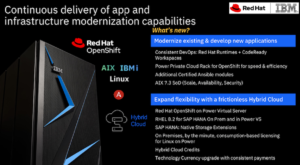IBM, Red Hat Integration Continues as IBM Mainstreams Power Systems in Pivot to Cloud

As it continues to pivot to the cloud, IBM has unveiled a new Power-based private cloud rack product line that is also porting Red Hat OpenShift capabilities to its Power products. The moves for the Power-microprocessor-based products are part of a realignment with IBM's corporate-wide strategy, which iappears to be de-emphasizing HPC to target more traditional enterprise and cloud/hybrid cloud markets.
Steve Sibley, IBM vice president of global offering management, described the strategy as a way to give customers agility and flexibility for their workloads to be on-premises or in the cloud while helping them with application modernization. "This is the hybrid cloud transformation story with an emphasis from our standpoint on making that as frictionless as possible for clients, " said Sibley. "We’ve implemented Power systems in the IBM Cloud in a way that mirrors the architecture most of our clients use on-premises. Our ISVs are supporting us for the most part without [requiring] retest and recertification. You can run SAP HANA, you can run on Oracle, you can run all of the AIX and IBM offerings on premises or in the cloud [on Power systems]."
The application moderinzation capabilities are a second part of the puzzle for customers, said Sibley. “Most clients recognize the value of cloud native [and] all the new development on containers and with microservices. Most of it is extending what they already have versus completely rewriting everything. They may keep their core business applications running on Oracle or DB2 environment, or running on a traditional VM, but then with APIs and connectors into new services such as mobile payments or risk analytics ... that are getting [things] written in OpenShift.”
OpenShift is a family of containerization software products developed by Red Hat. Its core product is the OpenShift Container Platform — an on-premises platform as a service built around Docker containers and orchestrated and managed by Kubernetes on Red Hat Enterprise Linux (RHEL). Among other things, OpenShift is positioned as a powerful enabler of hybrid cloud use.
Here are the highlights excerpted from the IBM announcement:
- Expanded Red Hat Capabilities on IBM Power Systems – IBM Power Systems now features Red Hat OpenShift on IBM Power Virtual Server leveraging OpenShift’s bare metal installed Red Hat Runtimes, and newly certified Red Hat Ansible Content Collections.
- New IBM Power Private Cloud Rack Solution – Providing clients an optimized, production-level OpenShift platform to modernize traditional environments with cloud-native applications, the IBM Power Private Cloud Rack combines on-premises hardware, a complete software stack of IBM and Red Hat technology, and installation from IBM Systems Lab Services to deliver 49% lower cost per request as compared to similarly equipped x86-based platforms.
- Extended Dynamic Capacity – Enhancements to IBM Power System’s dynamic capacity to quickly scale compute capacity across the hybrid cloud on Linux, IBM i, and AIX.
Parsing IBM’s Power-based cloud offerings can be confusing. It has two similarly named products, the Power Private Cloud Rack, which is the new solution bundle being announced today, and the Power Private Cloud with Dynamic Capacity, which is a renaming of what was “Enterprise Pools 2.0.” Finally, IBM’s uber Power Cloud, distinct from its x86-based IBM Cloud, is called IBM Power Virtual Services and consists of Power-based infrastructure loosely co-located with IBM’s x86-based cloud.
IBM says that customers can use the products to leverage Red Hat OpenShift and deliver a user experience that is largely indistinguishable from that experienced in the x86 landscape, but which IBM claims offers better performance and lower TOC.
IBM hopes its Power portfolio will ride OpenShift’s growing popularity. Sibley noted Red Hat’s Ansible automation platform (provisioning, configuration, etc.) and its Marketplace (OpenShift-certified software) as important in the mainstreaming of Power systems by making them easier to use and support. Along those lines, IBM reported just adding “22 new Ansibles modules that bring new automation capabilities for common tasks like patch management, security management, OS and application deployment, continuous delivery, centralized backup and recovery, and virtualization management and provisioning.” That brings the total number of POWER-supported Ansible modules to 102.
IBM recently reported that the new Power cloud rack products will be available in two deployment sizes:
PPC Rack for new deployments
- Three-node configuration, or more
- Includes an IBM FlashSystem 5200, IBM Storage Networking SAN24B-6 switches, and an optional LAN switch
- Contains Red Hat Enterprise Linux (RHEL) 8, IBM PowerVM Enterprise Edition, IBM Cloud PowerVC Manager, Red Hat OpenShift Container Platform (OCP), and Red Hat OpenShift OpenShift Container Storage (OCS)
PPC Rack starter deployment
- Single-node configuration
- Network File System (NFS) storage only
- Includes RHEL 8, PowerVM, PowerVC, and Red Hat OCP
Power Systems enhancements
- The PCIe3 2-Port 16 Gb Fibre Channel (FC) Adapter, which was originally announced with AIX OS support only, now provides support for Linux.
The new systems are Power9 microprocessor-based but there are plans to bring Power10 systems to market said IBM.
It will be interesting to watch the Power/OpenShift gambit play out.
This article first appeared on sister website, HPCwire.












